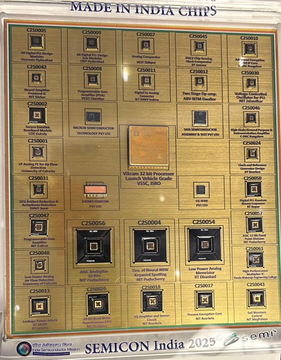The Silicon Revolution: How India is Powering the Chip Economy
- samarwealth

- Sep 8
- 3 min read
Picture this: you’re scrolling on your smartphone, streaming a show on Netflix, while your car outside charges silently. A world of invisible intelligence is at work behind the scenes — and it all comes down to a tiny, unassuming hero: the semiconductor.

These chips are not just components; they’re the brains of modern technology. From laptops and data centers to electric vehicles and MRI machines, semiconductors quietly run the world. And now, India is stepping onto the global stage with ambitions to become a chip powerhouse.

Why Semiconductors Matter

For decades, electronics relied on bulky vacuum tubes. Then came the transistor, the integrated circuit, and the microprocessor — each leap smaller, faster, and more powerful. Today, billions of transistors sit on a single chip, enabling breakthroughs in AI, 5G, automation, and renewable energy.
In simple terms: no semiconductor, no smartphone. No EVs. No data-driven world.
India’s Position in the Value Chain
Globally, the semiconductor industry is valued at $600 billion (2024) and is set to hit $1 trillion by 2030. Yet, supply remains highly concentrated — Taiwan alone accounts for over 80% of advanced chip manufacturing, and ASML in the Netherlands controls 100% of EUV lithography machines.

This overdependence has triggered a global rethink. Enter India — democratic, stable, and increasingly central to the chip story.

Today, nearly 20% of the world’s semiconductor design engineers are based here, working for giants like Intel, Qualcomm, Nvidia, and MediaTek across Bengaluru, Hyderabad, and Noida.

The Market Opportunity
India’s semiconductor market stood at $44 billion in 2023 and is projected to soar to $110 billion by 2030, nearly 10% of the global market.
By Application (2030):
Handsets: $33B
IT & Telecom: $34B combined
Consumer Electronics: $11B
Industrial Electronics: $10B
Automotive: $8B
By Component (2030):
Processing: $33B
Memory: $20B
Connectivity: $14B
Power, Sensors & Others: $10B
The scale is undeniable. The question is: can India build not just demand, but supply?
Growth Drivers in Play
Policy Push: The India Semiconductor Mission (₹76,000 crore) provides up to 50% fiscal support for fabs, display plants, packaging units, and compound semiconductors.
Incentives: Design-linked schemes promise up to 70% project cost coverage for startups and local IC/IP design firms.
Global Collaborations: Japan has committed ~₹5.5 lakh crore investments, with Tokyo Electron entering Gujarat and Assam, and Rapidus exploring 2nm technology partnerships.

Skill Development: Over $800 million earmarked for R&D and training 60,000 semiconductor engineers, plus new fabless design centers.

Expansion and Innovation

The launch of India’s first indigenous chip — the Vikram 32-bit processor at Semicon India 2025 — is more than symbolism. It marks the country’s shift from being a design hub to a player with manufacturing ambitions.
With OSAT/ATMP units and full-stack plans underway, India is laying the groundwork for end-to-end semiconductor capability.




Risks That Cannot Be Ignored
Manufacturing Gap: India is strong in design but still lags in fabs and advanced manufacturing.
Global Concentration: While diversification is underway, advanced lithography and cutting-edge foundries remain dominated by foreign players.
Execution Challenges: Policy incentives must translate into timely ground execution, or momentum could stall.
The Road Ahead
By 2025, India’s semiconductor industry is projected at $8–9 billion with its first fabs in place. By 2030, domestic capacity could reach $20–25 billion, meeting a quarter of the country’s demand. Fast forward to 2050, and India could be a $100–150 billion semiconductor hub, with strong exports, global partnerships, and advanced sub-28nm capabilities.
This is not just about chips. It’s about securing India’s place in the future of technology, reducing global supply chain risks, and building the foundations of generational wealth — one chip at a time.
Stay ahead of India’s tech transformation
Disclaimer: The above analysis is for educational purposes only and should not be considered as a buy or sell recommendation.




Comments